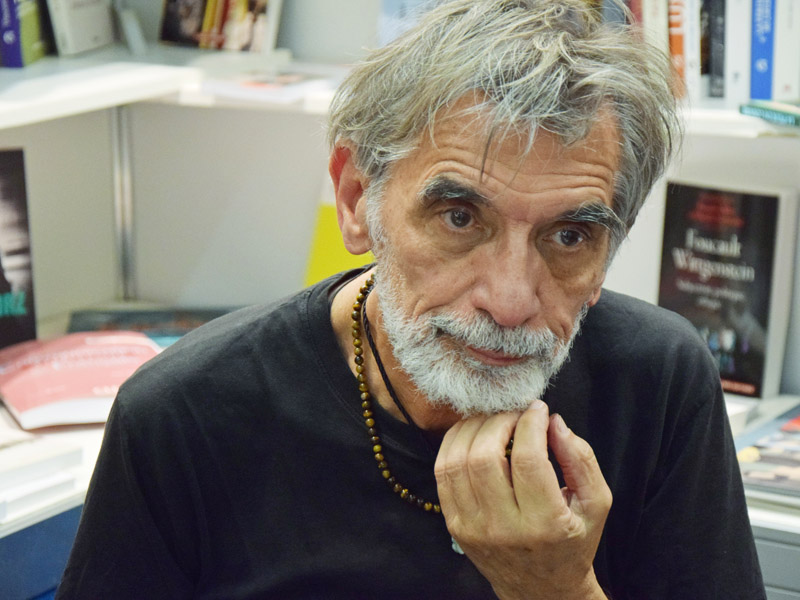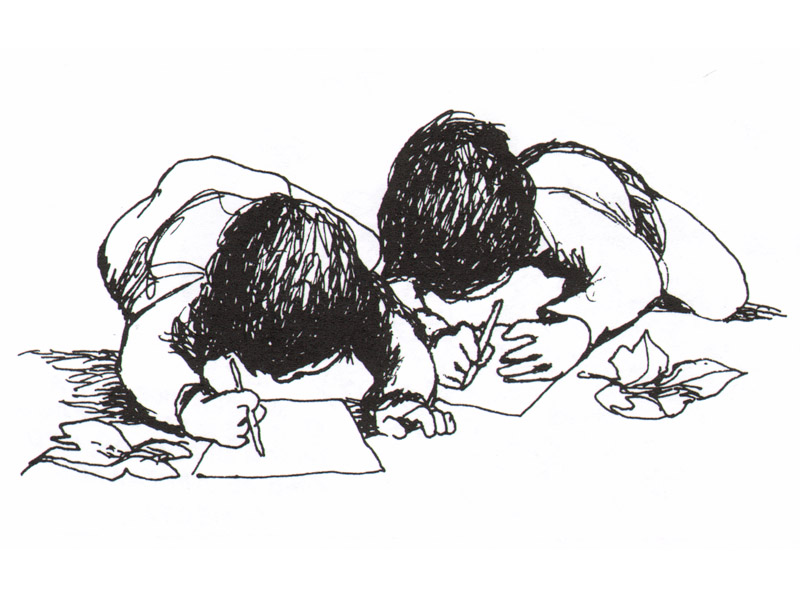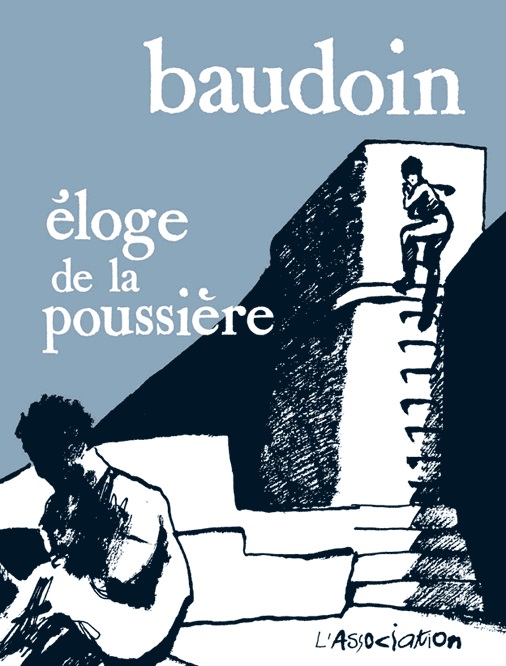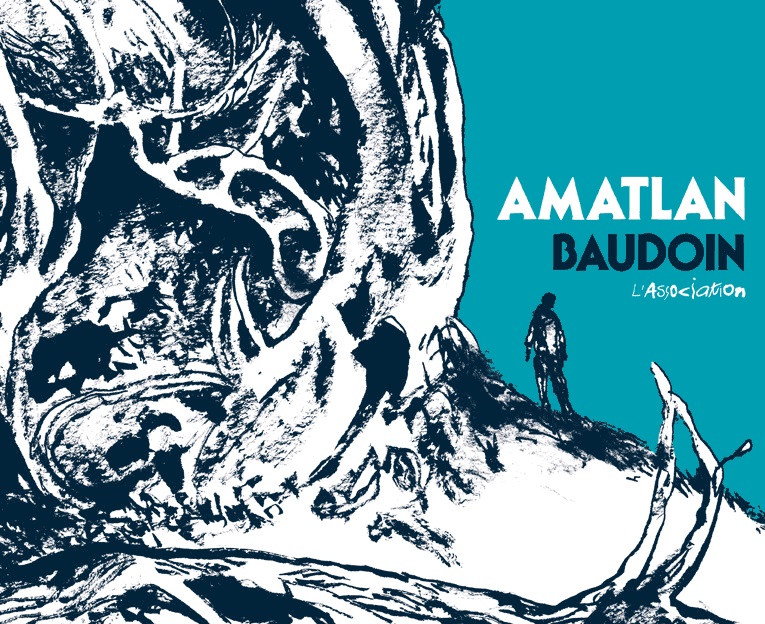
The French artist-illustrator Edmond Baudoin is lauded as a classic author of comics in his homeland, while his black-and-white graphic novel Piero [English edition: New York Review Comics, 2018. ISBN 9781681372969. Translation by Matt Madden] is on official school reading lists for children ages 9-12. This touching story is a memoir of childhood, coming of age, and the power of a dream. Its heroes are two inseparable brothers who love drawing. One of the brothers, Pierre, studies at the School of Fine Arts in Paris. The second, Edmond, works as an accountant until age thirty and only then decides to resurrect his childhood dream and draw his first book. Today, he has nearly eighty.
Papmambook’s correspondent sat down for an interview with Edmond Baudoin, to chat about family history, the particulars of an artist’s work, and the inner music which he has sought to understand and convey to others all his life.
- Edmond, how did you come to love drawing? Did your parents somehow nudge you and your brother in that direction?
- Yes, my dad did draw some. He may have dreamed of being an artist. Children always seem to realize the dreams of their parents, whether the parents didn’t dare to pursue their dreams when they were younger, or they are afraid their kids will start drawing, because it’s not a very profitable line of work. But children can read their parents’ minds, even if nothing is said. They read their thoughts in the air. Even if the parents don’t say “I want you to be an artist,” if they just think it, the child will hear that thought. My mother, for example, was a simple peasant. She didn’t know how to read or write, but she would always say “If I knew how to write, I would write books.” That was her dream.
- Do you think you would have the same passion for drawing if you were growing up today?
- My brother was always saying that if we’d grown up with a Nintendo console, maybe he wouldn’t have picked up drawing. But I know I would have drawn anyway.
It often happens that I’m out signing books and a little boy comes up to me and looks at me, his eyes bright as I draw. And then right away one of the parents shows up and starts to pull him away: “Come on, we have to go home.” But he doesn’t want to, he’s trying to stay, he’s interested. I ask him, “Do you like drawing?” And he says, “yes.”
So this “bug,” this passion for drawing—it’s not going anywhere. Whether we have TV or Nintendo, there will always be children who love drawing. I don’t know where it comes from. If you’d like, I can tell you why most children quit drawing.
- Yes, please. Because of the parents, right?
- Of course, this is my personal opinion, I’m not a sociologist. You have a small child drawing and she says, “Here’s mom, and here’s dad.” It’s beautiful and everyone agrees. But when she reaches five or seven years or so, she sees Mom, Dad, and the cat as they are, in all their complexity. This is a critical moment, because for the first time, the child starts to understand that he can’t draw them. Children stop drawing, because at some point, abstraction, stick figures, are no longer enough for them, and they prefer to stop drawing altogether.
- So what are the parents of these self-critical children to do?
- Parents should help a child bridge the gap between the understanding that you’ll never be able to do it, and the fact that you should keep going anyway. A child already knows that he’ll never draw Mom and Dad like he’s “supposed'' to, but someone should help him and show him that it’s fine that he can’t just yet. He can still try to make the drawing better. Then the child sees that his drawings are getting better, that progress is possible and you can keep growing. If every child had such a guide, a lot more people would draw. That’s not to say everyone would be an artist, but there would be more of them. I don’t mean professional artists—I mean people who draw for pleasure, simply because they find it enjoyable and interesting. Like people who sing and practice music for pleasure.
- When you were illustrating Piero, did you show your brother your sketches for the book? Was he a part of the process in some way?
- He actually drew the cover for Piero. He was very happy with the book and he approved of everything. He did say “You have a funny way of looking back on our childhood…” Because he had experienced it in his own way. And if he were to write his own book, it would be different. It makes perfect sense. If we’d had ten brothers, each would have his own recollection of childhood. Nobody sees things in exactly the same way.

Image: nyrb.com
- Do you have any other autobiographical books besides Piero?
- Yes, many. I have books where I’ve told the true story of my grandparents (I knew both of my grandmothers). My mother died of Alzheimer’s and I wrote a book [Original edition: Éloge de la Poussière. L'Association, 2000. ISBN 9782909020433] about my sense of that time, when her head was no longer working at all. I know many people run into a similar problem in life and feel the same way. I say in the book that, at one point, I understood that I actually wanted her to die, because that kind of life brought no joy, even for her. It’s very difficult to say that plainly and even harder to draw it, because there’s the physical likeness …. But I felt that if I dare to say it openly in the book, someone reading it might say: “Here’s a person just like me and he thinks like I do…” That, after all, is literature. That’s why we need books—to be an individual among other individuals.

Image: lassociation.fr
Whenever I start work on an autobiographical book, it’s important to me that I show the readers that I am like them. I have to feel like a part of humanity. The book should reflect those feelings that are common to us, not just personal ones, showing me with all my weaknesses, but also in my strength.
- Edmond, how do you get new ideas for your books. Is it always something that worries you at a given moment?
- Yes, that’s exactly how it happens. I do less and less “personal” books these days, because I don’t want to repeat myself. But there is an autobiographical book I do want to make, which I’ve been writing for the past three years. The book is about what it means to age. I started on it because I realized that no comic book artist had seriously taken on the subject—“how a person grows old.” There are so many authors around the world that do autobiography, but I’m one of the first, so I’m probably one of the oldest. (Laughs)
I draw wrinkly skin as it becomes drier and drier, and that picture is much stronger than words. The same things are perceived differently depending on whether they’re written or drawn. The visual choice is always more forceful toward the image of a person, so an illustration tells us more intensely of the way we age and die. This subject concerns us all, because everyone ages, and inevitably runs into the same problems. In this way you remain a part of humanity.
- How do you usually start work on a book? Do you write out a plan, make drawings?
- Here, I’ll show you. (Takes a thick notepad from his backpack.) I always carry a notepad with me. Ideas for new books almost always come to me while I’m out walking. I walk a lot. I walk, see things, and write everything down. I take a lot of notes and draw pictures to accompany them. I have a huge stack of notepads like this, and I divide them into two types. The first is just for notes of any kind. But when I have an idea, I have a special series of notepads just for the ideas for a particular book.
- And when you get enough notes for a book, how do you arrange them?
- First I write it like an ordinary book. Then I identify the main idea and throw out everything that’s superfluous. There’s a huge amount of work that happens before I even get started on the book. I toss out practically everything, because the drawing has to take precedence. But if I don’t do this preliminary work, then the drawing will never appear. So the order is as follows: notepad—writing—throwing out—drawing. How much time does pre-drawing work take? Maybe a year, maybe two, or even three. This isn’t to say that I don’t do anything else. I work on other books. But as soon as I get to the drawing itself, things go very quickly, and it takes me about six months on average.
- Which of your books that hasn’t yet been translated to Russian would you like to share with a Russian audience?
- That’s a difficult question. As far as I’ve understood, the Russian public is not yet quite used to the language of comics. So I would suggest books that are simple in their composition, similar in structure to Piero. Piero is very important to me as well, but my best-known books are so complex, in terms of their composition as well, that readers may not understand them at all. It’s an unusual thing, that a comic book can be broken up with whole pages of literary text, and then there’s an illustration. Then it suddenly goes back to a comics-based narration.
- Could you name one of the books you have in mind?
- If you go to my site, you’ll find the covers of all my books. The most complex is Amatlan [Original edition: Amatlan. L'Association, 2009. ISBN 9782844143013]. Amatlan is a Mexican town where I had a very strong, but also rather tough romance. There is a lot of text in the book…. there are simpler books with less text—Le Chemin de Saint-Jean [Original edition: Le Chemin de Saint-Jean. L'Association, 2002. ISBN 9782844140944], for example, named after a road in my village. It has a green cover. It may be the most important book for me.

Image: lassociation.fr
- I know you worked for a long time in Japan….
- Most of my books tell about a little village in the south of France. I was born in Nice in 1942, but my culture comes from a tiny village 50 kilometers from Nice. I am literally steeped in its air. That’s why the Japanese invited me to work in their country (I asked). So they invited me not because I draw manga as they do, but because I draw my stories about a tiny village. For three years, I worked for the Japanese market, for magazines, which came out weekly with a circulation of 1.5 million copies. Naturally, I had to adapt to the Japanese reader and I did all my work “backwards”—right to left.
- I heard your lecture for students at the British School of Design and what you said about the inner music which guides an artist, was very interesting.
- I am 75 years old now and I still try to listen to my inner music. Always. I’m sure that I will die without having understood it. But there’s nothing sad in that. That’s human life—an attempt to understand one’s inner music and transmit it to others. That’s how Stravinsky, whom I love, thought and what he tried to do with his music. Sadly, I was never able to ask him, but I am sure that at the end of his life, he wasn’t very happy—it’s likely that he, too, wasn’t able to understand what he wanted to do and what he wasn’t able to hear. Life is a stroll, just a long stroll.
- Do you think that young readers are able to understand the music of an artist?
- I travel a lot and I see that children everywhere, whether in the United States or in China, feel the same way. If I draw a line like this [draws a horizontal line] and ask an eight-year-old, or even a four-year-old, what music they hear deep in their heads, when they see this plain line… all of them, without exception will do this: “Sh sh sh sh.” Or they do a sound like this: “eh eh eh eh.” I understand that it seems stupid, but somehow the ocean horizon makes us think of precisely that sound: “eh eh eh eh.” And if I draw a line like this for a child [draws a wavy line], they start to sing “eah, eah, eah.” And that’s exactly right. But why? Nobody taught us this. It’s not part of any particular culture—American, French, or any other. But that has been human nature since the dawn of time. A caveman thirty thousand years ago would have thought of the same sounds upon seeing these pictures. Look how they drew and how their music sounds. A child of eight can already read very complex images…. In other words, everything you draw is music. And the most important thing is finding your own music.
- So, the secret of every creator is in their inner music? How does one find it?
- If professors and teachers could explain it, things would be a lot easier. In any art you have to feel at all times as though you’re standing on the edge of an abyss. Our life is that abyss. It doesn’t matter how old you are. The decision to “fall” into your life will be just the first step, because you also have to reach the very bottom in one piece. We’re afraid, after all, we’re dizzy. We have a right to that fear. Still, we have to dive in, that’s what it takes…. Imagine the shyest person. If he dares to dive into the abyss of his shyness—alone, at home, in a calm setting—he’ll be able to say things anyone in the world will understand. The important thing is to dare to do it. If he does, it will be the best book about shyness—an important book, wonderful, especially for children. There are so many shy children out there.
- How can you teach a person to “fly” into their own abyss?
- You have to figure it out for yourself. Some never learn to fly and I have no right to judge them. I’ve always refused to judge others’ drawings. For me it was very difficult, especially when I taught at university. You have to give grades there, of course and students need those grades, and direction. But I never gave grades. How do you grade “Potato Eaters” Van Gogh’s first painting? What would you give it? Now, the work is worth billions. But it’s awful, a bad painting. If a teacher had given him a “zero,” we wouldn’t have had a chance to get to know Van Gogh, who changed painting forever. Art is life and it shouldn’t be graded.
Interview by Maria Kostiukevich
Russian-French interpretation by Mikhail Khachaturov
Photos by Galina Solovyova
Piero book cover: nyrb.com
Translated from the Russian by Alisa Cherkasova
Follow us on Facebook.
